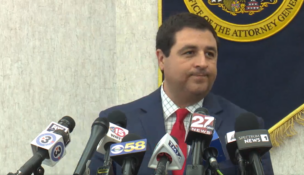Extinguishing the fuse on the ‘litigation explosion’ myth
By: dmc-admin//May 21, 2003//
 If you listen to its critics, our civil justice system is a smoldering volcano, spewing forth a “litigation explosion,” which buries our court system in a lava-flow of frivolous lawsuits that paralyze our economy. Sanity, it is argued, can only be restored by tort “reform” — reducing levels of accountability by making it harder to sue businesses, placing ceilings on recovery and moving disputes from courtrooms to “alternative” forums, perhaps sponsored by the business itself.
If you listen to its critics, our civil justice system is a smoldering volcano, spewing forth a “litigation explosion,” which buries our court system in a lava-flow of frivolous lawsuits that paralyze our economy. Sanity, it is argued, can only be restored by tort “reform” — reducing levels of accountability by making it harder to sue businesses, placing ceilings on recovery and moving disputes from courtrooms to “alternative” forums, perhaps sponsored by the business itself.
Unfortunately, much of the debate on the weaknesses of the civil justice system relies on dubious anecdotes, questionable research, concocted statistics, factual and legal misstatements and a willful disregard of contradictory evidence.
If the civil justice system is to survive as a vital part of society, it is imperative that lawyers educate themselves and the public about the workings of the courts, exposing misconceptions and turning the tide against the “litigation explosion” myth.
Tort Filings Small Part of the Court’s Workload
Those claiming there is a “litigation explosion” have generally referred to an increase in tort cases, cases involving personal injury or property damage, rather than the full range of civil cases. Recent statistics from the Wisconsin Director of State Courts show:
dTorts, those cases that encompass product liability, personal injury and medical malpractice, made up 8,581 cases out of a total of 256,596 civil case filings, including uncontested small claims, in 2001. That’s just 3 percent of civil case filings.
dTort filings have actually decreased over the last 10 years both in absolute numbers and as they relate to Wisconsin’s population. In 1991, there were 10,785 tort cases filed compared to 8,581 in 2001. Tort cases declined from 219.2 cases to 159.2 cases per 100,000 residents, a decrease of 27 percent.
Product Liability
To put the approximately 8,500 cases filed annually into perspective, let’s look at specific examples of types of cases. In 2001, 85 product liability cases were filed in Wisconsin. That means only 1.6 product liability cases were filed in 2001 for every 100,000 Wisconsin residents. Despite this anemic number, the Legislature is now being asked to radically change the whole product liability area — limit the manufacturers’ liability to 15 years after the machine was produced; create defenses with regards to a product that complies with state and federal standards; dismiss a claimant’s action if the injury was caused by a product that had an inherent characteristic that would be recognized by an ordinary person; limit the circumstances where retail sellers of the products would be held liable for damages from the product not manufactured by them; and applying comparative negligence to strict liability claims. Why the Legislature is considering radically changing an entire area of the law for 85 cases is incomprehensible.
Medical Malpractice
In the area of medical malpractice, there were only 256 medical malpractice lawsuits filed in Wisconsin in 2001. Despite the amount of medical negligence currently harming patients in this country — between 44,000 and 98,000 deaths occur each year in U.S. hospitals due to medical errors according to the Institute of Medicine — very few victims file suit and those who do often have a very difficult time winning their cases.
The small number of cases corresponds to the findings in the 1990 Harvard Med-ical Practice study, which found that eight times as many patients are injured by medical malpractice as ever file a claim; 16 times as many suffer injuries as receive any compensation. Despite this well-documented pattern, Wisconsin enacted a cap on noneconomic damages in 1995. Proponents of the cap argued that one of its main benefits was to lower health care costs and increase access to health care in rural areas. However, recent reports found health care costs in southeast Wisconsin are 55 percent higher than the Midwest average. Like other states with noneconomic damage caps, health care costs have continued to rise and doctor shortages are still common in rural areas.
So who really benefits with caps? Certainly not injured patients, who are thrice penalized: first by negligent health care providers, causing pain, suffering and injury; second by limiting the amount of noneconomic damages juries can award; and third by facing ever-higher health care costs.
Auto Cases
The largest number of tort cases result from motor vehicle crashes. There were 5,013 “personal injury, auto” cases filed in 2001. Compare that number with the 58,279 persons injured and 764 killed in motor vehicle crashes in 2001. That means approximately one person out of every 12 injured or killed in a motor vehicle crash filed a lawsuit. Despite the fact that 58 percent of all tort cases filed are automobile-related, no one has claimed there was an au
tomobile insurance “crisis” in Wisconsin. In fact, Wisconsin consumers pay almost 30 percent less per year for automobile insurance than consumers nationwide, ranking fifth lowest in the nation for automobile insurance rates in 1999. Wisconsin’s comparatively low cost of auto insurance shows how effective Wisconsin’s current civil system is in compensating injured consumers while leaving insurance premiums affordable.
| |
||
| |
||
Conclusion
Wisconsin court statistics reaffirm there never was, nor is there now, a “litigation explosion” in Wisconsin. While tort “re-formers” still espouse their anti-civil justice system message, it has increasingly been shown it is fundamentally false.
Past Wisconsin tort “reform” measures have been enacted relying on a rhetoric fostering fear and anxiety, not on empirical evidence. There certainly is no justification for enacting additional “reforms” that limit Wisconsin citizens access to justice.
While the “litigation explosion” myth has clearly been developed and disseminated through a deceptive yet sophisticated marketing campaign, its widespread acceptance by the media and public threatens the foundation of the civil justice system. We must do all we can to extinguish the fuse on the “litigation explosion” myth.
To read the full article on this subject, “We Aren’t Seeing You In Court,” go to www.watl.org, and click on “The Verdict.”
Ruth Simpson is the Research Director of the Wisconsin Academy of Trial Lawyers.
Legal News
- Judge reject’s Trump’s bid for a new trial in $83.3 million E. Jean Carroll defamation case
- The Latest: Supreme Court arguments conclude in Trump immunity case
- Net neutrality restored as FCC votes to regulate internet providers
- Wisconsin Attorney General asks Congress to expand reproductive health services
- Attorney General Kaul releases update at three-year anniversary of clergy and faith leader abuse initiative
- State Bar leaders remain deeply divided over special purpose trust
- Former Wisconsin college chancellor fired over porn career is fighting to keep his faculty post
- Pecker says he pledged to be Trump campaign’s ‘eyes and ears’ during 2016 race
- A conservative quest to limit diversity programs gains momentum in states
- Wisconsin prison inmate pleads not guilty to killing cellmate
- Waukesha man sentenced to 30 years for Sex Trafficking
- 12-year-old shot in Milwaukee Wednesday with ‘serious injuries’
WLJ People
- Power 30 Personal Injury Attorneys – Russell Nicolet
- Power 30 Personal Injury Attorneys – Benjamin Nicolet
- Power 30 Personal Injury Attorneys – Dustin T. Woehl
- Power 30 Personal Injury Attorneys – Katherine Metzger
- Power 30 Personal Injury Attorneys – Joseph Ryan
- Power 30 Personal Injury Attorneys – James M. Ryan
- Power 30 Personal Injury Attorneys – Dana Wachs
- Power 30 Personal Injury Attorneys – Mark L. Thomsen
- Power 30 Personal Injury Attorneys – Matthew Lein
- Power 30 Personal Injury Attorneys – Jeffrey A. Pitman
- Power 30 Personal Injury Attorneys – William Pemberton
- Power 30 Personal Injury Attorneys – Howard S. Sicula











